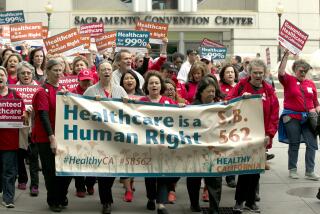Limited Scope in Patients’ Bill
WASHINGTON — When the House takes up the patients’ bill of rights legislation today, more than 40 million Americans without health insurance will be sitting on the sidelines, largely ignored by lawmakers here.
For those who already have health insurance--primarily the middle class and above--the patients’ bill of rights would give significantly more leverage in disputes with their HMOs and other health plans about coverage, emergency care and access to specialists.
But it would do nothing for the masses of low-paid workers who remain without coverage even after a decade of record national prosperity.
And the uninsured aren’t the only major group who are bypassed by the patients’ bill of rights. Another consists of the 16 million elderly and disabled Medicare recipients who have no prescription drug coverage. Although some members of Congress have proposed to plug this gap, it now looks likely that there will be no action this year.
In a recipe for stalemate, the Bush administration says it won’t agree to a drug benefit without a major overhaul of Medicare, and the Democrats want to add drug coverage without altering Medicare.
Ever since Congress turned down former President Bill Clinton’s national health insurance program seven years ago, it has remained deadlocked on many of the day’s major health-care financing issues.
What to do about the uninsured has so split the parties that doing nothing has become the likeliest outcome. Republicans, who favor free-market solutions, prefer tax credits and medical savings accounts to encourage individuals to buy insurance. Democrats, with their enthusiasm for government programs, would like to expand current federal coverage for children to include their parents.
President Bush is “strongly committed to providing health insurance coverage to the uninsured through tax credits and the community health centers,” Scott McClellan, a White House spokesman, said Monday, noting that the budget projects $71 billion in tax credits and $20 billion to expand the work of local health centers over the next 10 years.
But the tax credits didn’t make it into the big tax bill the president signed this year, and their fate is problematic now that the Democrats have gained control of the Senate.
Experts say both parties overlook just how hard it is to expand coverage. “The arguments are often more ideological than practical,” said Dr. Mark Smith, director of the California HealthCare Foundation, which works on health and coverage issues.
Both parties proceed as if their particular approach “is something which uninsured people desperately want and will grab at,” he said. But “this often isn’t the case. This is much harder than it seems,” he said, noting that some small-business owners don’t realize they can deduct the cost of providing coverage for their workers. At the same time, millions of people who already are eligible for government programs don’t bother to enroll. In California, 1.9 million children are covered under public programs. But more than 1.2 million others are not despite their immediate eligibility.
About 726,000 children could get health insurance free under Medi-Cal, the program for the poor. And an additional 535,000 children could be covered at a cost to their families of just $4 to $9 a month under Healthy Families, the state’s version of a national program that subsidizes the cost of insurance for families with limited incomes (up to $36,575 a year for a family of three).
“We still talk to families who don’t know about the program; getting the word out is very important,” said Dawn Horner, associate director of the Children’s Partnership in Santa Monica, a nonprofit group dealing with children’s issues.
Some families don’t want to get involved with any government program at all, Smith said. They scorn it as welfare, worry that the information will be shared with the immigration authorities or balk at the paperwork and documentation required.
And still others feel they don’t need health insurance at all because they can get care in the neighborhood. “Many of them will go to public clinics,” Smith said.
The budget resolution passed by Congress calls for $28 billion to be spent over 10 years to expand coverage for the children’s health insurance program. But it is not clear whether this money will still be available if the budget surplus shrinks as the economy weakens. And there will be competition from other spending programs.
The budget resolution also calls for $300 billion to be directed toward covering pharmaceuticals under Medicare for the first time since the federal health program was created in 1965. Fashioning a benefit will be difficult, with Congress wary because drug prices are rising rapidly and the consumption of new and more effective drugs is increasing dramatically each year. Even among advocates of a benefit, there is great concern about its future budgetary impact when the baby boom generation begins retiring in another decade.
(Applications for Medi-Cal and Healthy Families may be obtained by calling [888] 747-1222.)
More to Read
Get the L.A. Times Politics newsletter
Deeply reported insights into legislation, politics and policy from Sacramento, Washington and beyond. In your inbox three times per week.
You may occasionally receive promotional content from the Los Angeles Times.










